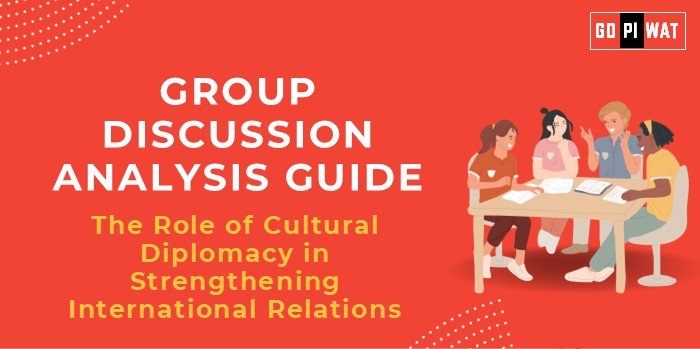📋 Group Discussion Analysis Guide
🎭 The Role of Cultural Diplomacy in Strengthening International Relations
📝 Introduction to Cultural Diplomacy
🌍 Opening Context
Cultural diplomacy serves as a bridge for fostering mutual understanding and collaboration among nations, highlighting its growing importance in a globally interconnected world.
📜 Topic Background
Dating back to ancient exchanges like the Silk Road, cultural diplomacy has evolved into a strategic tool for nations to showcase their cultural identity and influence global perceptions. In the modern era, organizations like UNESCO and initiatives such as the Fulbright Program exemplify its impact.
📊 Quick Facts and Key Statistics
- 🌟 UNESCO Creative Cities: Over 295 cities globally foster international cooperation through cultural exchange.
- 🎓 Cultural Exchange Programs: Over 40,000 Fulbright scholars annually facilitate academic and cultural exchange.
- 💰 Economic Impact: Cultural and creative industries contribute over $2.25 trillion to the global economy annually, demonstrating their soft power potential.
- ✈️ Tourism as Diplomacy: Cultural tourism represents 40% of global tourism, enhancing cultural ties and economic cooperation.
🤝 Stakeholders and Their Roles
- 🏛️ Governments: Design policies and fund cultural exchange programs.
- 🌐 International Organizations: Promote global collaboration (e.g., UNESCO, UN Alliance of Civilizations).
- 🎨 Artists and Cultural Ambassadors: Represent and share their nations’ cultures on global stages.
- 📚 Educational Institutions: Host exchange programs fostering intercultural understanding.
🏆 Achievements and Challenges
✨ Achievements
- 🌍 Global Understanding: Programs like Erasmus+ promote unity within the EU by supporting over 9 million cultural exchanges since 1987.
- 💼 Economic Benefits: US-China cultural diplomacy has contributed to $1.65 trillion in bilateral trade.
- 🎻 Conflict Resolution: Music and arts initiatives in conflict zones, like the West-Eastern Divan Orchestra, bridge divides.
⚠️ Challenges
- 🎭 Cultural Appropriation: Misrepresentation risks diplomatic strains.
- 💸 Resource Inequities: Developing nations face underrepresentation due to limited funds.
- 🛑 Political Tensions: Sanctions and conflicts can hinder cultural collaboration.
🌍 Global Comparisons
- 🇫🇷 Success: France’s Alliance Française has over 800 centers in 133 countries, promoting French culture.
- 🇮🇷 Challenges: Restrictions in Iran limit cultural exchanges with Western nations.
💡 Structured Arguments for Discussion
- ✅ Supporting Stance: “Cultural diplomacy fosters mutual understanding, reducing conflicts and building partnerships.”
- 🛑 Opposing Stance: “Cultural diplomacy risks being co-opted as propaganda or sidelined by political agendas.”
- ⚖️ Balanced Perspective: “While cultural diplomacy bridges gaps, its success depends on equitable resource distribution and genuine intent.”
🎯 Effective Discussion Approaches
- 📊 Opening Approaches:
- Start with a compelling statistic, such as global creative industries’ economic contribution.
- Highlight an inspiring case, like UNESCO’s intangible cultural heritage efforts.
- ⚡ Counter-Argument Handling:
- Address political misuse by proposing neutrality through non-governmental oversight.
🧠 Strategic Analysis of Strengths and Weaknesses
- 💪 Strengths: Soft power influence, conflict resolution, global branding.
- 🛠️ Weaknesses: Resource inequities, political misuse.
- 🌟 Opportunities: Digital cultural diplomacy, public-private collaborations.
- ⚠️ Threats: Geopolitical tensions, cultural homogenization risks.
🏫 Connecting with B-School Applications
📚 Real-World Applications
- Align with business strategies for international markets by leveraging cultural understanding.
🎓 Sample Interview Questions
- ❓ “How can cultural diplomacy influence international trade?”
- ❓ “What role do businesses play in cultural diplomacy?”
📘 Insights for Students
- 💡 Apply cultural diplomacy principles to leadership and global collaboration projects.


